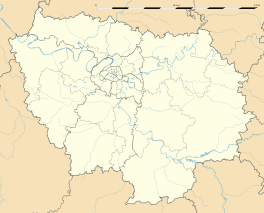Montereau-Fault-Yonne
| Montereau-Fault-Yonne | |
|---|---|

Bridges over rivers Seine (foreground), Yonne (background) and statue of Napoléon
|
|
| Coordinates: 48°23′07″N 2°57′03″E / 48.3853°N 2.9508°ECoordinates: 48°23′07″N 2°57′03″E / 48.3853°N 2.9508°E | |
| Country | France |
| Region | Île-de-France |
| Department | Seine-et-Marne |
| Arrondissement | Provins |
| Canton | Montereau-Fault-Yonne |
| Intercommunality | Deux Fleuves |
| Government | |
| • Mayor (2008–2014) | Yves Jégo (UDI) |
| Area1 | 9.1 km2 (3.5 sq mi) |
| Population (2012)2 | 16,682 |
| • Density | 1,800/km2 (4,700/sq mi) |
| Time zone | CET (UTC+1) |
| • Summer (DST) | CEST (UTC+2) |
| INSEE/Postal code | 77305 / 77130 |
| Elevation | 47–121 m (154–397 ft) (avg. 53 m or 174 ft) |
|
1 French Land Register data, which excludes lakes, ponds, glaciers > 1 km² (0.386 sq mi or 247 acres) and river estuaries. 2Population without double counting: residents of multiple communes (e.g., students and military personnel) only counted once. |
|
1 French Land Register data, which excludes lakes, ponds, glaciers > 1 km² (0.386 sq mi or 247 acres) and river estuaries.
Montereau-Fault-Yonne (French pronunciation: [mɔ̃.tʁo fot jɔn]), or simply Montereau, is a commune in the Seine-et-Marne department in the Île-de-France region in north-central France.
The city takes its name from its geographical position on the confluence of the Yonne and the Seine rivers. Fault, also spelled faut comes from the verb faillir ("to fail") in its old meaning to fall. Montereau is where the Yonne falls into the Seine.
The town is split in three by the rivers, ville basse situated on the southern shore and Surville on the hill to the north. The old town centre is located in ville basse while Surville is an assembly of high rise buildings, erected after World War II, and is in many ways a typical cité in the Île-de-France. Some of these high rise buildings are now (2005) going to be destroyed and replaced by individual houses. The old château-park in Surville (now the site of a high school Lycée André Malraux) however gives a very nice view over the confluent and the Seine-et-Marne region. On the east side, between the two rivers, are the port and an industrial park.
In 1359, the King of Navarre Charles II of Navarre, who held the town because of his Champagne ascent, lost it to the regent of France (the future king Charles V).
...
Wikipedia


